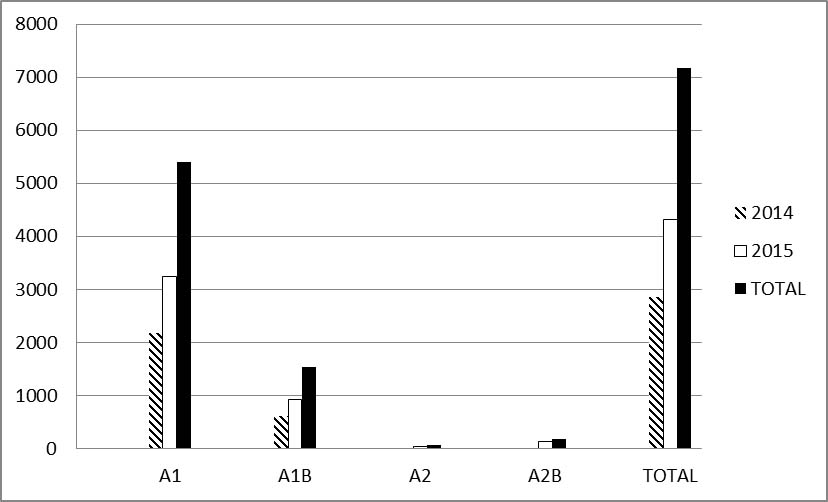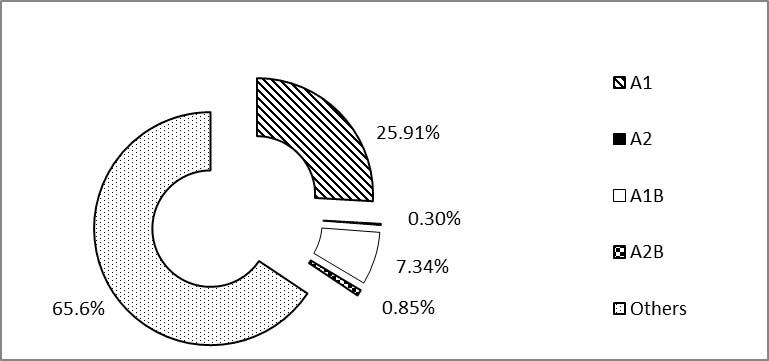Discovery of ABO system of blood groups by Landsteiner in 1901 marked the beginning of safe transfusion [1,2]. Till today, it is the most important blood group system in transfusion medicine [2]. There are four main blood groups enlisted in this system namely A, B, AB and O [1,3].
Subtypes of A antigen have been defined, based on which A and AB blood groups have been classified into two main subgroups each. Approximately, 20% of individuals having A antigen in blood belong to A2 and thus, forming either A2 or A2B subgroups while rest belong to A1, so as to form either A1 or A1B subgroups [3,4]. Subgroups of A antigen weaker than A2 are not frequent [2].
A1 and A2 are distinguished by the reactivity of lectin i.e., anti-A1 which occurs as a cold agglutinin and exclusively agglutinates A1 cells. About 0.4% A2 and 25% of A2B subgroups possess anti-A1. These antibodies become clinically significant if they react at 37°C destroying A1 cells [2].
The aim of our study was to assess the prevalence of A1 and A2 subgroups in the population studied and it’s implication in transfusion practices.
Materials and Methods
An analysis was performed on blood groups of donors coming to Karnataka Institute of Medical Sciences, Hospital, Hubli, blood bank. This was a retrospective study done for a period of two years; from January 2014 to December 2015. The data was collected with due and relevant permission obtained from the Head of the Department of Pathology and Blood Bank. Also, ethical clearance for the study was obtained from the Institutional Ethical Committee. The identity and the gender of the donors was not revealed in any manner in the study conducted. The blood collected from donors was typed for ABO and Rh grouping by standard tube as well as slide technique [5].
For blood groups positive for A antigen, i.e., group A and AB, further testing with anti-A1 lectin was conducted [5]. The individuals were hence, classified under sub-blood groups containing A1 or A2. The data was tabulated and assessed.
Results
ABO grouping was analysed for 20,864 donors over a period of two years. Of these, 5466 (26.20%) belonged to group A and 1708 (8.20%) belonged to group AB. Blood groups other than A and AB accounted for 13,691 (65.6%) donors.
Out of the total study sample, A antigen was present in 7174 (34.4%) of the donors (A and AB blood groups). Of this, A1 antigen was present in 6938 (96.7%) donors and A2 antigen was present in 236 (3.3%) donors.
A1 and A1B sub-types were found in 5406 (75.4%) and in 1532 (21.3%) donors respectively, while A2 and A2B subtypes were found in 60 (0.8%) and 176 (2.5%) donors, respectively.
Of 5466 donors of A blood group in the two years of our study, 5406 (98.90%) belonged to A1 subtype and only 60 (1.10%) belonged to A2 subtype. Year wise distribution has been given in [Table/Fig-1].
Distribution of A1 and A2 subtypes in A and AB blood groups in two years.

On the other hand, out of 1708 donors of blood group AB, 1532 (89.70%) of the donors were classified under A1B and 176 (10.30%) donors under A2B.
In this study, it was observed that the occurrence of A2 in AB blood group as A2B was more than the occurrence of A2 in A blood group.
Out of the total individuals having A antigen in blood, 268 donors (3.73%) were found to be Rh negative. Of these, 220 (82.08%) were A1 negative, 44 (16.41%) were A1B negative, 1 (0.37%) was A2 negative and 3 (1.11%) were A2B negative.
The distribution of blood groups in all individuals is shown in [Table/Fig-2].
Percentage of blood groups in all individuals over two years.

Out of the total 20,864 donors in two years, prevalence of A1 positive was 24.86%, A2 positive was 0.3%, A1B positive was 7.13% and A2B positive was 0.84%. Prevalence of A1 negative was 1.05%, A1B negative was 0.21%, A2B negative was 0.014% and A2 negative was 0.004%.
Discussion
ABO blood group was the first blood grouping system discovered by Landsteiner [1]. It includes different genotypes and phenotypes of A, B and O antigens. 44.6% of all blood groups are A which includes two subtypes i.e., A1 and A2 with a prevalence of 80% and 20% respectively [6].
The present study was conducted on 20,864 donors over a period of two years. Their distribution revealed increase in the number of donors within a span of one year from 2014 (39.45%) to 2015 (60.55%).
In present study, A group was prevalent in 26.2% and AB in 8.2%. In a study from USA, prevalence of A and AB was found to be 37.1% and 4.1%, while in England it was found to be 41.8% and 3% respectively [7]. In a study from Odisha, India, prevalence of A group was 22.3% [3].
In present study, amongst all the donors having A antigen in the blood 5466 (5406 + 60) (76.20%) were A group and 1708 (1532 + 176) (23.80%) were AB which was almost same as a study in Sudan in which prevalence of A was 76% and AB was 24% [2]. Present study also showed that A1 was more common in A group and A1B more common in AB which was in agreement with study done in Sudan and parts of Southern India [2,8-10].
A1 and A2 are major subgroups of blood group A. These are differentiated by the reaction of anti-A1 lectin with A1 cells. Rarely, significance of weaker variants like A2, A3 and Ax is important as they may cause haemolytic transfusion reactions [11]. A2 and A2B are rare subgroups. Individuals having these subgroups do not recognize A1 antigens as their own hence, make up specific anti A1 antibody against A1 cells. About 0.4% of A2 and 25% of A2B have anti A1 antibodies [2,12].
In present study, prevalence of A1 and A1B was 25.91% and 7.34% and A2 and A2B was 0.30% and 0.85% respectively of all donors in our blood bank. In a study done on the Muslim population of UP by Hussain R et al., the prevalence of A1 and A1B was 26.52% and 19.34% and A2 and A2B was 2.90% and 1.24% respectively [13]. Their study was similar to a study done by Ara G et al., in which prevalence of A1, A1B, A2 and A2B was 24.64%, 20.21% 3.97% and 1.60% respectively [14]. Present study showed lower values as compared to other studies done in India. A study from South India showed prevalence of A2 and A2B as 3.01% and 1.43% respectively [10]. Another study by Chaitanya Kumar IS et al., concluded that prevalence of A2 and A2B is 0.85% and 1.21% respectively [15]. In a study done by Sharma DC et al., in which A2 and A2B were found to be 8% and 8.6% respectively [16].
In present study, prevalence of A1 and A2 in A blood group was found to be 98.90% and 1.10% respectively. Prevalence of A1B and A2B in AB blood group was 89.70% and 10.30% respectively. These results were similar to the study done by Bangera IS et al., in which prevalence of A2 and A2B in groups A and AB respectively was 1.3% and 12.7% [8].
In a pilot study by Chaitanya Kumar IS et al., done in Rayalseema region, values of A2 and A2B in A and AB blood groups respectively were 4.1% and 19.2% [15]. These were higher as compared to our study. Similar studies were done by Mahapatra S et al., showed A2 and A2B as 5.8% and 31.5% and study done by Shastry S et al., which showed 1.07% A2 and 8.99% A2B respectively [3,9].
Prevalence of A1 and A2 antigens in individuals with A and AB blood groups was found to be 96.7% and 3.3% respectively in this study. This was similar to a study by Esmaili HA et al., in which A1 was 94.6% and A2 was 5.4% respectively [17]. Mahapatra S et al., concluded A1 to be 88.1% and A2 to be 11.9% of all individuals having A or AB blood group [3].
Present study showed that the prevalence of A2B in AB blood group was much more than the prevalence of A2 in A blood group which was in agreement with the other studies [2,3,8,9,15].
The prevalence of A2 and A2B along with Rh negative status is rare. In general population, A2B subtype is found in 0.9% to 1% individuals [6]. Rh negative blood groups are found in 15% of the population [16]. Considering both, the prevalence of A2B negative is 0.1%. In present study however, A2B negative was found to be 0.014%. A2 negative was found to be 0.004% among all donors during the study period [Table/Fig-3]. This aspect of transfusion medicine has not been emphasised in other studies and hence, this study helps to link the prevalence of subgroups of A antigen with Rh status of the individual and aids in precision of transfusing blood and preventing transfusion related reactions.
Year wise distribution of subtypes of A and AB blood groups in study period.
| Blood Group | Year-2014 | Year-2015 |
|---|
| A1 Positive | 2093 | 3093 |
| A2 Positive | 30 | 29 |
| A1B Positive | 575 | 913 |
| A2B Positive | 43 | 130 |
| A1 Negative | 80 | 140 |
| A2 Negative | 1 | 0 |
| A1B Negative | 31 | 13 |
| A2B Negative | 3 | 0 |
Limitation
This study can be continued prospectively for further more years to get a comprehensive and large donor pool; from which more statistically significant analysis can be expected to be derived to more closely relate the importance of the sub types of Blood Group A.
Conclusion
A1 and A2 are rare subgroups. However, they may lead to transfusion related reactions which could be lethal. By knowing the prevalence of A1 and A2 subgroups in a blood bank at tertiary care hospital, the dangerous transfusion reactions occurring due to these minor incompatibilities can be avoided. Therefore, implementation of A1 and A2 grouping in ABO typing is vital for curtailing the avoidable reactions leading to overall improvement in blood transfusion practice.